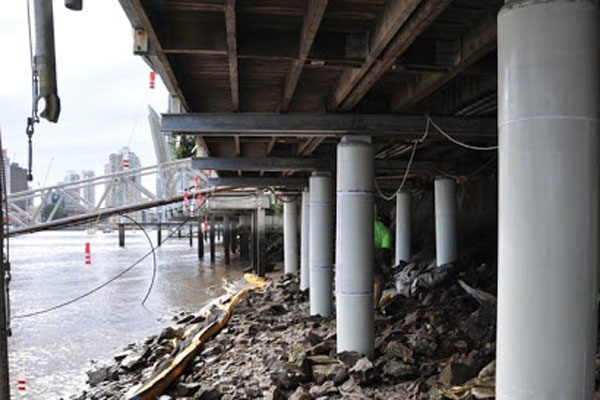FRWD (First Repair Worst Defect) was conceptualized in the early nineties while we were working on Rehabilitation of housing societies in Mumbai. This concept was propounded as large volume of defects had to be attended to within a very limited budget. Such budgetary constraints are common when undertaking a rehabilitation project. The same is true, when we start Bridge management on any network. If during the service life, the bridges are not being properly maintained, then it is possible that during the first cycle of inventory and inspection many bridges will show distress. Over a period of time when, all the major defects are attended using FRWD, it is feasible to deploy RAFS (Repair At First Symptom). RAFS technique is applicable for a network where all bridges are in a safe Rating zone.
UBMS (Unified Bridge Management System) is considered efficient when the philosophy for attending repairs, adopted by the system, ensures that distress is attended to as soon as it is noticed. RAFS ensures this efficiency.
First Repair Worst Damage (FRWD)
FRWD is a repair strategy that was propounded during the early nineties when major rehabilitation projects were undertaken in Mumbai for scores of housing societies. Each of the housing societies was undertaking remedial activities for the first time since it’s construction. Such a decision, to undertake remedial action, is prompted by large scale manifestation of signs of distress in the structure. Initial symptoms of distress are most of the time neglected as such symptoms do not hamper the safety and functioning of the structure. Only when the symptoms get manifested into severe distress symptoms, do the client start to worry about the safety and performance of the structure.
When remedial action is undertaken for the first time under major budgetary constraints, then it is not feasible to attend to all the defects within the limited budget. Since financial constraints exist, and the extent of distress is so large and widespread that all symptoms cannot be resolved within the allocated budget. This leads to a budgetary constraint situation. Under such situations, it becomes important to select areas of distress which need to be attended to in the first cycle of remedial action. FRWD strategy was evolved, as a solution to the financial constraints and large scale distress.
On the road network, we have multiple bridges. In the absence of legislation that mandates implementation of BMS, the client normally allows some time to elapse before the symptoms get reported and then the decision to implement remedial measures is taken. BMS implementation is supposed to avoid such a delay in rectification of distress. In India, with a proactive minister in place, it took 70 years post-independence and over 50 years after initial infrastructure construction, that decision to implement IBMS on national highway was initiated. At that stage, most bridges (over 60 %) had lived past their design life and the network had over 100. Bridges, which were more than 100 years old and still in use. Many bridges had undergone multiple surface restoration cycles and were maintained superficially. IBMS in the first cycle resulted in over 140 bridges being declared critical in condition. The annual budget provided to actual maintenance is few thousand rupees per kilometre of highway. The normal annual budget is not sufficient to undertake major rehabilitation activities during implementation of BMS. Independent financial support is absolutely essential for sustainability of activities in IBMS. Till such a financial support is created, the implementation of BMS is on a shoestring budget. Such a scenario is the most ideal situation for implementation of FRWD on the network.


The level of financial support needs to be sufficient for continuing operations of IBMS. FRWD strategy is short term solution till important bridges are taken out of critical listings.
Since for National Highways, IBMS was implemented for the first time in totality, it was important to identify bridges that need to be replaced. The criterion applied for this decision making was to identify bridges which are from the subset of structurally critical bridges and also from the functional inadequate bridge’s subset. All such bridges which were functionally inadequate and also structurally critical, these bridges were immediately assigned to be replaced. Age of bridge forms an important criterion to decide the usefulness of repair intervention. Age becomes critically important in the decision making because most bridges are found to be functionally inadequate when they approach the mid service life.


TRANSITION FROM FORWARD TO RAFS
Once BMS is implemented on a network, it ensures that bridges on critical listings are provided with required remedial action. Sustained implementation of BMS ensures all bridges are moved from critical bridge listings to safe bridge listing. The time taken for such transition will directly depend on the level of financial support available. On Indian National highway network, the total number of bridges is 38,330. Bridges with Structural Rating below 5 define the subset of bridges that need remedial intervention. As of July 2019, the number of such bridges, which were part of the subset of bridges, with structural rating below or equal to 5, was 5706. To attend to each of the bridges and move it from the subset of ratings below 5 to a subset of ratings above 5 would need a budgetary support of over INR 5,000 to 15,000 crores, which is impossible to provide in the short term. The average cost of structural repairs on a bridge is 1 to 2.5 crores. The large volume of bridges which need maintenance intervention makes it critical for IBMS to achieve fast transition from FRWD to RAFS. When a remedial intervention is provided to a bridge, the Structural ratings improve. During this transition from rating below 5 to rating above 5, one needs to first attend to bridges with structural ratings below 2 which form the critical subset within the distress bridge subset. Bridges with structural ratings below 2 start to show improvement in the ratings as post repair inventory and inspection yields a higher rating for the bridge.
From critical bridge subset, the bridge could either move to need an attention bridge with ratings either 4 or 5 or directly to safe bridge subset with structural ratings above 5. If the remedial intervention is encompassing all problems, the bridge could move to a safe zone where the structural ratings are all above 5. Initially under FRWD, bridges with ratings below 2 (critical bridge subset) are attended to by providing remedial interventions. Subsequent to attending to the critical bridge subset, bridges that have ratings from 3 to 5 are attended to. Each year during inventory the list of bridges in critical or distressed bridge subset undergoes addition, with new bridges previously in safe bridge subset may move from safe to distressed bridge subset.
The goal of FRWD is to ensure that over time all bridges move from critical bridge subset to planned attention required bridge subset and finally to Safe bridge subset. When the entire bridge inventory in a network is in the safe bridge listing, the usefulness of FRWD is over and it’s time for the BMS to shift strategy to RAFS.

At times, when the bridge shows critical structural ratings and also poor functional efficiency, the bridge could be considered for replacement. As of July 2019, on the IBMS database there were about 5706 bridges which were structurally in need of repair intervention. From the 5706 bridge which were structurally in need of repair intervention, 5000 number of bridges were also found to be functionally inadequate. Of these 5000, many could be candidate bridges for replacement. Such a large number of bridges in need of intervention in a limited budget makes it impossible to attend to in one year or even in 5-year span of time. This will result in a protracted period of time essential for FRWD to be applied.
Repair At First Symptom (RAFS)
Under any BMS, when the remedial intervention strategy moves from FRWD to RAFS it can be said that the BMS has moved from working in critical mode to working efficiently. As the synonym indicates RAFS ensure that funds are allocated to the bridge to rectify the first symptom of distress. When all bridges are rendered safe due to inputs of remedial action over a period of time, bridges can be provided required attention as and when the first symptom of distress is observed. Their structural safety is assured and any minor distress symptoms can be attended to. Application of RAFS strategy implies that the bridge inventory is in good condition on the network and that the BMS is working efficiently to provide interventions at the first required situation. Under RAFS, the volume of work on each bridge is minimal and the cost of repair is high.


Such increased cost is resultant of small volume of repair on each bridge. The overall number of bridges which need such intervention could be large. However due to logistics involved in bridge repair, it is at times essential to wait for the situation where one stretch of highway with say 20 to 50 bridges of varying length need such interventions. This ensures the cost of small repair does not skyrocket due to low volume involved over a specific length of highway. The National Highway network in India spans over 120,000 kms and has a bridge at every 3.25 to 3.5 kms on an average. So, taking a length of 100 to 150 kms would be an ideal situation to ensure that the cost of repair is reasonable.
During the RAFS implementation period, clients can shift their focus from structural safety to enhancement of Functional efficiency by attending to bridges that need to be modified to improve functional efficiency.
CONCLUSIONS:
FRWD is a very efficient strategy to adopt on BMS where the number of bridges in need of repair intervention is large and there exist financial constraints. Bridges having structural and functional inadequacy ideally are replaced to increase the efficiency of input cost. On Indian National highway network, FRWD strategy would yield results more efficiently as the number of bridges in need of structural repair intervention are large and available funds insufficient.
Transition from FRWD to RAFS occurs when all bridges migrate to safe bridge subset. Such transition is a prolonged transition on the national highway network in India due to volume of work involved.
RAFS strategy on BMS implies that the system is working under optimum condition. Cost of repair under RAFS strategy is always high due to the low volume of work involved. Modified RAFS strategy; where a 100 to 150 kms stretch of highway is taken up for repair intervention will ensure costs are maintained at reasonable levels.
About the author:

The article is authored by SACHIDANAND JOSHI, Emeritus Chair—IBMS @ IDDC Engineers Pvt. Ltd.
All of the author’s career has been devoted to the Rehabilitation of structures. He has been a team leader to over 2000 inspection, repair and rehabilitation projects. Having seen the various causes of distress so closely and the extent of damage and loss that is caused by ZERO maintenance of various structures, he decided to devote his energy to conceptualize a system that can avoid this scenario. From that urge to minimize distress, came his focus on Asset Management Program.
SACHIDANAND JOSHI is presently working passionately to implement Asset Management Programs in various facades of the Civil Engineering industry in India. The author has ha flair to conceptualize projects and get the team to complete the micro-planning.

